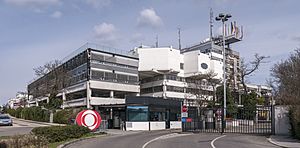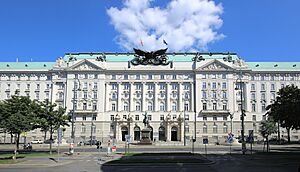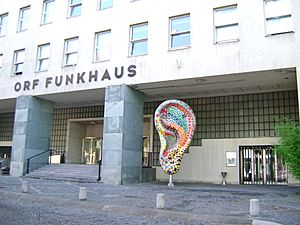ORF (broadcaster) facts for kids
 |
|

ORF-Zentrum Küniglberg (headquarters), designed by Roland Rainer and constructed from 1968 to 1975
|
|
| Type | Television and radio network |
|---|---|
| Country | |
| Availability | Austria; parts of Czech Republic, Germany, Hungary, Italy, Liechtenstein, Slovakia, Slovenia and Switzerland |
| Headquarters | ORF-Zentrum, Hugo-Portisch-Gasse 1, 1136 Wien, Vienna |
| Key people | Roland Weißmann (Director General) |
| Launch date | 1 August 1955 |
| Former names | Ravag (Radio Verkehrs AG) |
| Official website | |
Österreichischer Rundfunk (ORF) is Austria's main public TV and radio company. It's like the national broadcaster for the whole country. ORF gets its money from a special fee people pay for their TVs and radios. It also gets some money from ads.
For a long time, ORF was the only big TV company in Austria. Other countries nearby, like Germany, had private TV channels. But Austria was one of the last countries in Europe to allow private TV channels to broadcast everywhere.
Contents
How Austrian Broadcasting Started
The first radio tests in Austria began on April 1, 1923. A radio fan named Oskar Czeija started them. He used his phone factory in Vienna for the broadcasts. Later, he moved to a technical college.
On September 2, 1923, the Austrian President, Michael Hainisch, spoke on the radio. A year later, a strong radio transmitter was put on top of an old War Ministry building in Vienna.
Early Radio: RAVAG
In February 1924, a company called Radio-Verkehrs-Aktiengesellschaft (RAVAG) got the official permission to broadcast. Oskar Czeija became its director. Regular radio shows began on October 1, 1924. They were broadcast from the War Ministry building. This place became known as Radio Wien.
By the end of October 1924, 30,000 people were listening. By January 1925, there were 100,000 listeners. By 1934, new transmitters were built across Austria. This meant everyone in Austria could listen to Radio Wien. People paid a small monthly fee to listen.
Radio shows often had classical music, stories, and talks. But RAVAG also had shows for kids. They even had a show about arts and crafts. In 1925, they started broadcasting live from places like the Vienna State Opera. News was not a big part of the shows at first. This was to respect newspapers and the government's wish to stay neutral.
However, sports broadcasts began in 1928. In 1930, they covered the Austrian election in detail. By then, RAVAG had about 500,000 listeners. It had become a very popular way for people to get information and entertainment.
In 1934, Austria's government changed. The RAVAG studios were even involved in some fighting. During a time of political unrest, some people entered the studio. They announced that the leader, Engelbert Dollfuß, had resigned. He was actually killed in his office.
Dollfuß's successor, Kurt Schuschnigg, built a new broadcasting center. It was called the Radiokulturhaus. Today, it's known as Funkhaus Wien. The government used RAVAG to share its messages. They also broadcast live church services. This was to counter messages from German radio stations.
Radio During World War II
In 1938, Austria became part of Nazi Germany. RAVAG was shut down. A new station, Reichssender Wien, took its place. It was controlled by the main German broadcasting network in Berlin. One of the last RAVAG broadcasts was Schuschnigg's farewell speech. Hours later, the new station showed live broadcasts of Adolf Hitler's arrival in Austria.
During World War II, listening to "enemy radio stations" was very dangerous. But many people still listened to stations from Switzerland, the BBC, and Vatican Radio. These stations gave them real news. Reichssender Wien broadcasts were used for air raid warnings. The Funkhaus building was damaged by bombs in 1945. The main transmitter was blown up by retreating troops.
Radio After the War
After the war, Austrian radio started again on April 24, 1945. It announced a new Austrian government. A new Radio Wien station was created. It broadcast from the Funkhaus Wien building. Oskar Czeija was in charge again for a short time.
Austria was divided into parts controlled by different countries. The Western Allies (like the US and UK) started their own radio stations. These stations became very popular with young Austrians. The original Radio Wien broadcasts were mostly in the Soviet-controlled part of Austria. As the Cold War began, these broadcasts were seen as Communist messages.
By 1952, there were 1.5 million radios in Austrian homes. The stations run by the Western Allies were much more popular. In 1955, all the different regional stations joined together. They formed the Österreichisches Rundspruchwesen. This later became the Österreichischer Rundfunk GmbH in 1957. This was the start of today's ORF.
ORF Radio Channels
ORF has several popular radio channels:
- Ö1 – This channel focuses on culture and news.
- Hitradio Ö3 – This is a pop music channel.
- FM4 – This channel plays alternative music and is popular with young people.
The old Ö2 channel was replaced by nine regional channels. Each one is for a different Austrian state:
- Radio Burgenland
- Radio Kärnten
- Radio Niederösterreich
- Radio Oberösterreich
- Radio Salzburg
- Radio Steiermark
- Radio Tirol
- Radio Vorarlberg
- Radio Wien
- Radio Slovenski
All these radio channels can be heard on FM radio. They are also available digitally via satellite. You can also listen to all of ORF's radio channels online. There's even an extra 24-hour news channel, Ö1 Inforadio, available only online. It plays news from Ö1 and adds more news when Ö1 is playing music.
ORF Television Channels
ORF offers several TV channels:
- ORF 1
- ORF 2 (This channel also has special shows for different regions.)
- ORF 2 Europe
- ORF III
- ORF Sport +
- ORF Kids
- 3sat (This channel is a partnership with other European broadcasters.)
ORF TV channels are available through regular antennas and via satellite. ORF 1 and ORF 2 are usually encrypted on satellite. This means only people in Austria who pay the TV fee can watch them. ORF 2 Europe is not encrypted, so anyone in Europe can watch it via satellite.
ORF also supports HbbTV. This is a system that combines regular TV with internet content. ORF has been broadcasting 24 hours a day since March 6, 1995.
Regional Studios
ORF has a regional studio in each Austrian state. Each studio creates its own radio and TV shows. These shows are broadcast on ORF 2. For example, the studio in Tyrol also makes TV and radio for German-speaking people in South Tyrol, Italy.
Even though there are regional studios, many ORF shows are made in Vienna. This means Vienna is a big focus for most ORF productions.
How ORF is Funded
ORF gets its money from a special fee called a television license fee. This fee is managed by a company called GIS. The amount people pay changes depending on which state they live in. For example, in 2022, Styria had the highest annual TV license cost.
As of January 2024, the GIS system changed. The old TV license fee was replaced with a new compulsory household tax for ORF. This new system means that everyone in a household has to pay. It closed some loopholes, like removing an antenna from a TV to avoid paying the old fee. Now, the tax is for the household, not just for having a TV with an antenna.
Popular ORF Personalities
Many famous Austrian TV stars work for ORF. One of the most well-known TV presenters is Armin Assinger. He used to be a skier. Now, he hosts the Millionen-Show, which is Austria's version of Who Wants to Be a Millionaire?. Mirjam Weichselbraun, who used to be an MTV presenter, co-hosts Dancing Stars. This is Austria's version of Dancing With the Stars.
A popular comedy show on ORF is Wir sind Kaiser ('We Are Emperor'). In this show, comedian Robert Palfrader plays Emperor Robert Heinrich I. He invites famous guests and makes fun of them.
Some of the best-known news anchors include Ingrid Thurnher. She has won many awards as a popular presenter. Armin Wolf is known for his tough interviews on the late evening news show ZiB 2. Gabi Waldner hosts the weekly political show Report.
ORF Logos
The first logo for ORF was designed in 1968 by Erich Sokol. It was called the 'ORF eye'. Erich Sokol was also ORF's main graphics artist for many years. People often compared the 'ORF eye' logo to the 'CBS Eye' logo from the American TV company CBS.
In 1992, ORF asked a British designer named Neville Brody to create its new logo. This new logo was quickly nicknamed the 'ORF bricks'. The old 'ORF eye' logo was still used sometimes until 2011, when it was completely replaced by the 'ORF bricks' logo.
See also
 In Spanish: ORF para niños
In Spanish: ORF para niños
- Vienna Radio Symphony Orchestra





